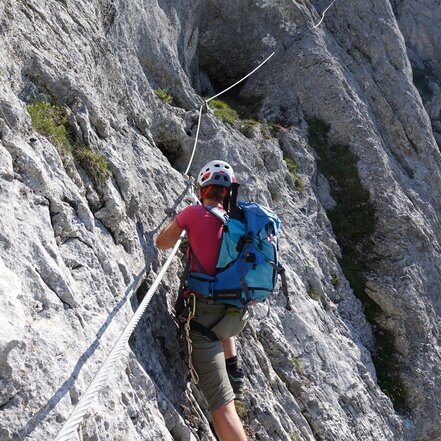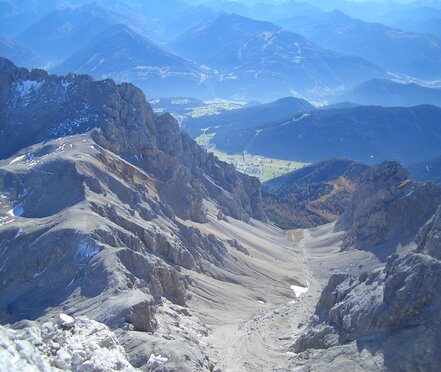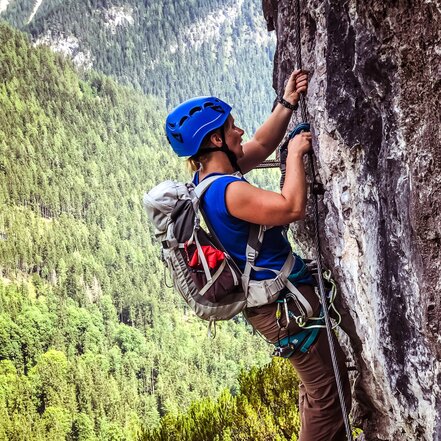Difficulty rating for via ferrata
The evaluation of difficulties in the course of a via ferrata is subject to subjective factors, just as with climbing routes, and can therefore only be indicative. An attempt was made to reconcile the problem of the subjectivity of difficulty ratings with a rating system that is as uniform as possible. This is complicated above all by subjective factors such as body size, technique, training condition, equipment, mental state, etc.), as well as by objective conditions (weather, wetness, icing, altitude, length, etc.).
A = easy (green)
Simple, secured paths. Flat (longer) or vertical (short) ladders and iron clamps mostly in not very steep terrain. Isolated spots can be exposed, but these are easy to walk on (e.g.: rock bands, small suspension bridges). The terrain is easy to walk even without belays (exception: ladders over small wall steps) and has good footholds and handholds. In general, sure-footed, giddy walkers do not yet need a via ferrata belay. A short safety rope may be required for children and inexperienced climbers.
B = moderately difficult (blue)
Already a somewhat steeper rocky terrain with partly small-step, exposed passages. Vertical, longer ladders, iron clamps, step pins or chains. Some passages are already strenuous and energy-sapping. Without insurances, the rock difficulties can reach up to the 2nd and 3rd degree of difficulty. Even many experienced mountaineers use basic via ferrata equipment here. For beginners and children, via ferrata equipment is absolutely recommended, as well as a short safety rope on longer ascents.
C = difficult (yellow)
Steep to very steep rocky terrain. Mostly small-step passages that are almost always exposed. Overhanging ladders, iron clamps and step pins, which can also be a little further apart (especially difficult for smaller people and children!). Often vertical sections, only secured with steel ropes. Some of them are already very strenuous. Without insurance, some steep sections would have a difficulty level of 3 or 4. Longer ascents at this level of difficulty already count as major via ferrata undertakings. For inexperienced climbers and children, rope belaying by an experienced partner is recommended. Self-securing is also advisable for experienced mountaineers.
D = very difficult (red)
Vertical, often overhanging terrain. Iron clamps and step pins are often far apart. Very exposed and steep rock, which in most cases is only secured with a steel rope. Longer, vertical to overhanging passages, where a fair amount of arm strength is required as well as a good overall physical condition. Sometimes also in combination with easy climbing (1-2), which has to be mastered without insurances. Even for very experienced climbers, complete via ferrata equipment is obligatory (mountain boots with tread rubber soles are advantageous!). This difficulty level is unsuitable for beginners and less experienced climbers. It is usually climbed in a rope team.
E = extremely difficult (black)
Extreme demands on strength, surefootedness (friction climbing shoes!) and freedom from vertigo are a prerequisite here! This level of difficulty is very rare in via ferrata. Rope team is obligatory; mostly combined with climbing. Otherwise as under "D", but all details at a higher level.





